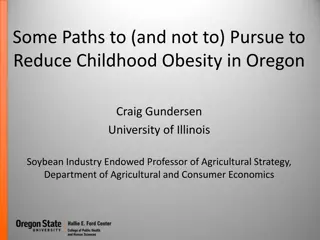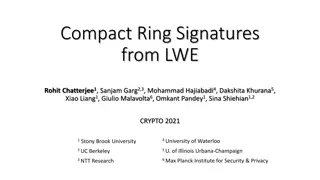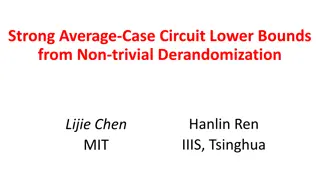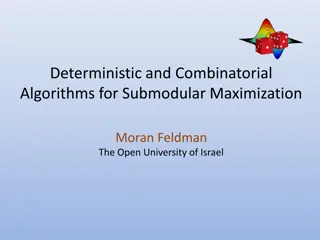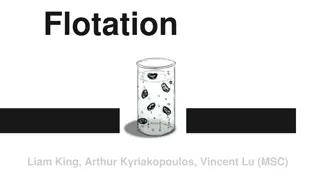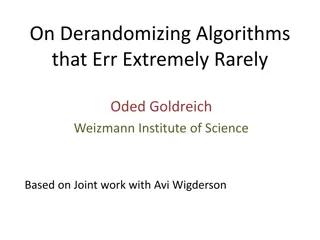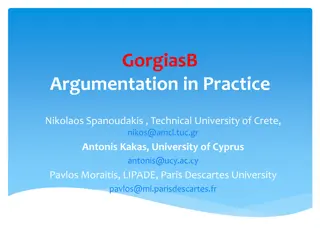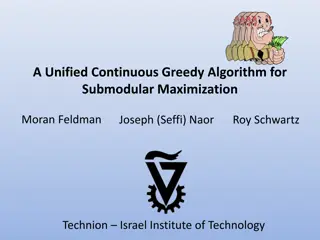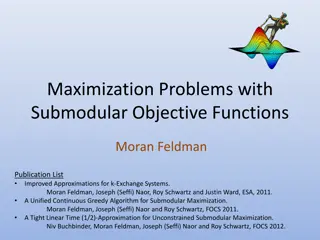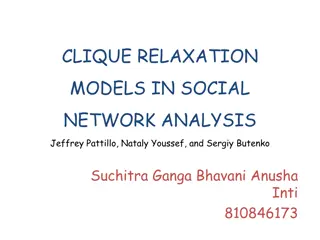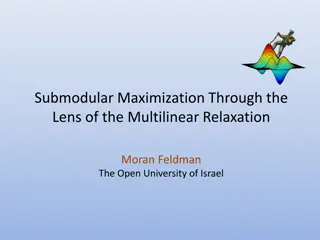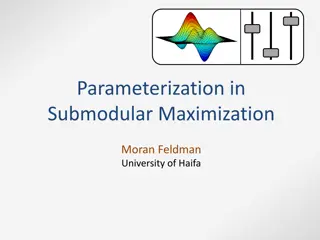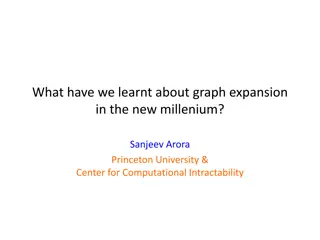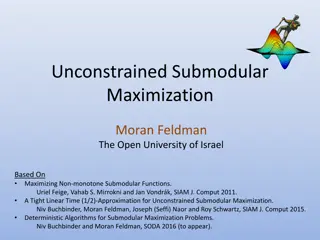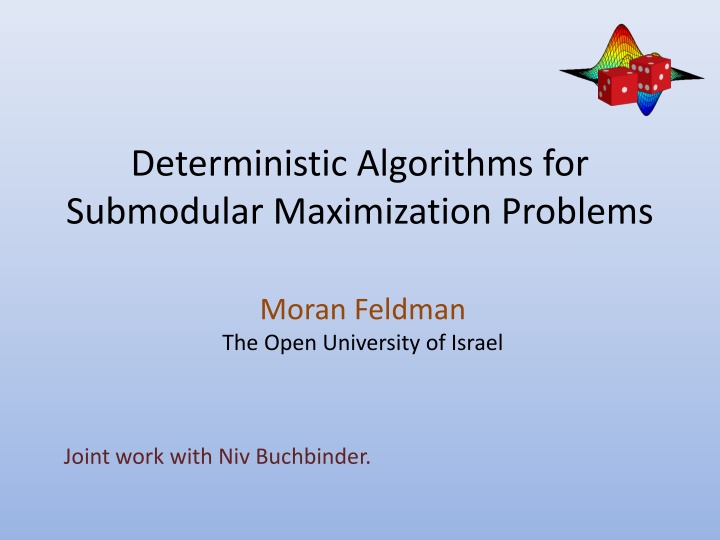
Deterministic Algorithms for Submodular Maximization Problems
"Explore deterministic algorithms for submodular maximization problems, with examples in cut functions and coverage functions. Learn about submodular functions, maximization problems, and the necessity of randomization. Discover a history of algorithms and approximation techniques." (Characters: 298)
Download Presentation

Please find below an Image/Link to download the presentation.
The content on the website is provided AS IS for your information and personal use only. It may not be sold, licensed, or shared on other websites without obtaining consent from the author. If you encounter any issues during the download, it is possible that the publisher has removed the file from their server.
You are allowed to download the files provided on this website for personal or commercial use, subject to the condition that they are used lawfully. All files are the property of their respective owners.
The content on the website is provided AS IS for your information and personal use only. It may not be sold, licensed, or shared on other websites without obtaining consent from the author.
E N D
Presentation Transcript
Deterministic Algorithms for Submodular Maximization Problems Moran Feldman The Open University of Israel Joint work with Niv Buchbinder.
Submodular Functions Definition Given a ground set N, a set function f : 2N R assigns a number to every subset of the ground set. A set function is submodular if: o f(A + u) f(A) f(B + u) f(B) o f(A) + f(B) f(A B) + f(A B) A, B N . A B N, u B or Submodular functions can be found in: Combinatorics (2 examples soon) Machine Learning Image Processing Algorithmic Game Theory 2
Example 1: Cut Function A directed graph G = (V, E) with capacities ce 0 on the arcs. For every S V: Observation: f(S) is a non-negative submodular function. ( ) S = f uc v , u S v S f(S) = 3 3
Example 2: Coverage Function Elements E = {e1, e2, , en} and sets s1, s2, , sm E For every S = {si1, si2, , sik}: Observation: f(S) is a non-negative (monotone) submodular function. ( ) S = f s i s S i S2 S3 S1 S4 S5 4
Submodular Maximization Problems Unconstrained Submodular Maximization Given a non-negative submodular function f : 2N , find a set S N maximizing f(S). Generalizes: Max-(Directed)-Cut. 12 Submodular Maximization with a Cardinality Constraint Given a non-negative submodular function f : 2N and an integer k, find a set S of size at most k maximizing f(S). Generalizes: Max-k-Coverage and Max-Cut with specified cut size. Other Constraints Exactly k elements, matroid, knapsack 5
Our Main Question Is randomization necessary for submodular maximization? Assume access via a value oracle: Given a subset A N, returns f(A). Algorithms should be polynomial in |N|. Representation of f might be very large. Reasons for not necessary Most approximation algorithms can be derandomized. Not necessary is the default Algorithms are assumed to access the function via a value oracle. This makes it difficult to apply standard techniques (e.g., conditional expectations). Algorithms based on the multilinear extension are inherently randomized. Reasons for necessary Currently most (best) known algorithms are randomized. 6
History and Results: Unconstrained Maximization Randomized Approximation Algorithms 0.4 non-oblivious local search [Feige et al. 07] 0.41 simulated annealing [Oveis Gharan and Vondrak 11] 0.42 structural continuous greedy [Feldman et al. 11] 0.5 double greedy [Buchbinder et al. 12] Approximation Hardness 0.5 information theoretic based [Feige et al. 07] Deterministic Approximation Algorithms 0.33 local search [Feige et al. 07] 0.4 recurisve local search [Dobzinski and Mor 15] 0.5 derandomized double greedy [this work] 7
History and Results: Cardinality Constraint Approximation Algorithms 0.25 local search [Lee et al. 10] 0.309 fractional local search [Vondrak 13] 0.325 simulated annealing [Oveis Gharan and Vondrak 11] 0.367 measured continuous greedy [Feldman et al. 11] 0.367 (faster) random greedy [Buchbinder et al. 14] 0.371 wide random greedy [Buchbinder et al. 14] Deterministic Approximation Hardness 0.5 for unconstrained maximization [Feige et al. 07] 0.491 symmetry gap [Oveis Gharan and Vondrak 11] Our Result 0.367 (e-1) derandomized random greedy [this work] 8
The Profile of the Algorithms Works in iterations. In every iteration: Starts with some state S. Randomly switches to a new state from a set N(S). For every S N(S), let p(S, S ) be the probability that the algorithm switches from S to S . The analysis works whenever the probabilities p(S, S ) obey k linear constraints that might depend on S, where k is polynomial: ( ) ( ( ) S p S S a S N S i ) ( ) S , , 1 , S c S i k i 9
Derandomization Nave Attempt Idea Explicitly store the distribution over the current state of the algorithm. The initial state (S0, 1) The number of states can increase exponentially with the iterations. (S1, p) (S2, 1 - p) (S6, q4) (S3, q1) (S4, q2) (S5, q3) 10
Strategy S p(S, S2) p(S, S3) p(S, S1) S1 S2 S3 The state Si gets to the distribution of the next iteration only if p(S, Si) > 0. We want probabilities that: obey the constraints. are mostly zeros. 11
Expectation to the Rescue , S The analysis of the algorithm works when: ( ) ( ) ( ) ( ) ( ) S S p , ( ) ( ) S , D D , 1 , D D a S S p S S c 1 i k i i S N S = , p S S S S N S ( ) S D D 0 S S N ( (D D is the current distribution). Often it is enough for the constraints to hold in expectation over D. D. ( ) ( ) ( ) ( ) ( ) S S p , c D D ( ) ( ) S , , , 1 a S S p S S S i k ~ D D ~ D D S i S i S N S = , 1 p S S S N S ( ) S D D 0 S S N 12
Expectation to the Rescue (cont.) Some Justifications We now require the analysis to work only for the expected output set. Can often follow from the linearity of the expectation. The new constraints are defined using multiple states (and their probabilities): Not natural/accessible for the randomized algorithm. True for the two algorithms we derandomize. 13
Finding a good solution Has a solution (the probabilities used by the original algorithm). Bounded. D D ( ) ) ( ) ( ) S , , 1 a S S p S S c S i k ( ) S ~ D D ~ D D S i S i S N S ( = , 1 p S The size of the distribution can increase by ( ) ) S N S ( ( ) S D D , 0 , p S at most k at every iteration. S S S N A basic feasible solution contains at most one non-zero variable for every constraint: One non-zero variable for every current state. k additional non-zero variables. 14
In Conclusion Deterministic Algorithm Explicitly stores a distribution over states. In every iteration: Uses the previous LP to calculate the probabilities to move from one state to another. Calculates the distribution for the next iteration based on these probabilities. Sometimes the LP can be solved quickly, resulting in a quite fast algorithm. Performance The analysis of the original (randomized) algorithm still works. The size of the distribution grows linearly in k polynomial time algorithm. 15
Open Problems Derandomizing additional algorithms for submodular max. problems. In particular, derandomizing algorithms involving the multilinear extension. Obtaining faster deterministic algorithms for the problems we considered. Using our technique to derandomize algorithms from other fields. 16


